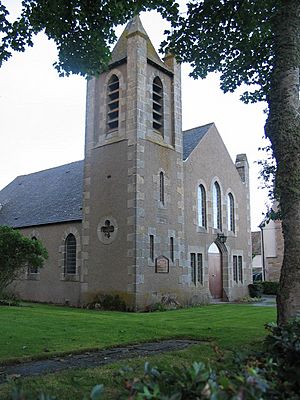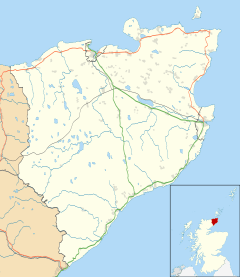Watten, Highland facts for kids
Quick facts for kids Watten
|
|
|---|---|
 Watten Parish Church |
|
| OS grid reference | ND242544 |
| Council area | |
| Country | Scotland |
| Sovereign state | United Kingdom |
| Post town | Wick |
| Postcode district | KW1 |
| Police | Northern |
| Fire | Highlands and Islands |
| Ambulance | Scottish |
| EU Parliament | Scotland |
Watten (which is Bhatan in Scottish Gaelic) is a small village in Caithness, Scotland. It is part of the Highland area. Watten is located on the main road (the A882 and A9) that connects the towns of Wick and Thurso. It is about 12 kilometres (8 miles) west of Wick. The village is also close to the Wick River and Loch Watten.
Watten used to have a Far North railway line station. However, trains stopped coming to the village in 1960. The old railway station building is now a private home.
The village is part of the parish of Watten. A parish is like a local area or district. Watten parish has Bower to the north, Wick to the east, Latheron to the south, and Halkirk to the west.
Loch Watten is the biggest body of water in Caithness. The name "Watten" for both the village and the loch comes from the Old Norse word Vatn. This word means "water" or "lake." The loch is very well known for its brown trout fishing. In fact, the local pub is even called "The Brown Trout" because of the fish found there.
Watten's Secret Prisoner Camp
During World War II, a military camp was built in Watten. This happened in early 1943. After the war ended, the camp became POW Camp 165. This camp was called "Britain's most secretive prisoner of war camp." This is because many important Nazis were moved there. They came from POW Camp 21 in Comrie, Perthshire.
Some of the famous prisoners included Gunter d'Alquen, who was a main propagandist for Heinrich Himmler. Another was Otto Kretschmer, a leading U-boat captain known as the "Wolf of the Atlantic." Also, SS-Sturmbannführer Max Wünsche was held there. The camp closed in 1948.
Famous People from Watten
Watten is the birthplace of Alexander Bain. He was an inventor who created a special type of electric clock. He also invented an early version of the fax machine. A carved stone monument stands outside the village hall to remember Bain. On this monument, the fax machine is called "The Electric Printing Telegraph."


